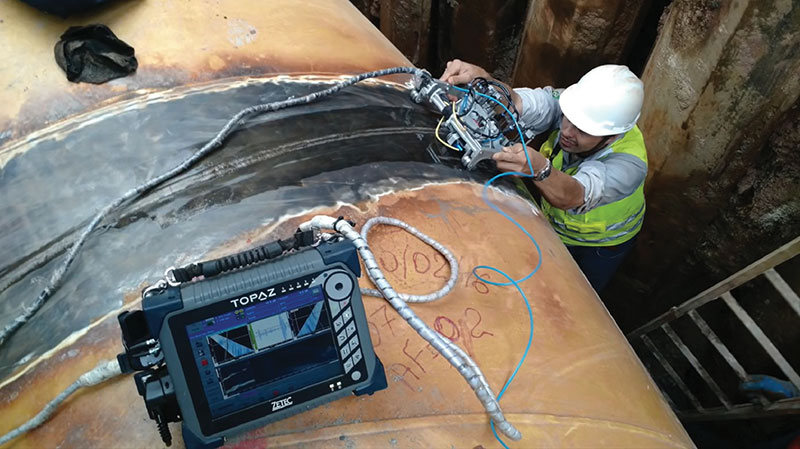Comprehensive Summary of Pipe Welding Evaluation Treatments
Pipe welding examination treatments play a crucial duty in ensuring that welded links fulfill rigid market standards and requirements. From careful pre-welding examinations to comprehensive post-weld analyses, a well-defined inspection procedure is important for keeping the structural sturdiness of pipes.
Pre-welding Assessment Preparations
Before beginning the welding procedure, extensive pre-welding inspection preparations are vital to guarantee the integrity and top quality of the weld joint. These preparations include a meticulous assessment of the materials to be bonded, the welding equipment, and the workplace. To start with, the products should be inspected for any kind of issues, pollutants, or disparities that could endanger the weld. This consists of checking for proper material grades, measurements, and surface area conditions. Pipeline Welding Inspection. In addition, the welding devices requires to be evaluated to verify that it is in great working condition, adjusted properly, and appropriate for the certain welding process. Any issues with the devices must be dealt with immediately to avoid issues in the weld. Lastly, the work environment must be reviewed for sanitation, proper ventilation, and safety measures to make certain a favorable setting for the welding operation. By conducting complete pre-welding examination preparations, prospective concerns can be recognized and settled beforehand, bring about premium and trustworthy weld joints.
Welding Procedure Credentials
Detailed pre-welding assessment preparations lay the foundation for the important process of Welding Treatment Certification, ensuring the honesty and quality of the weld joint. Welding Treatment Qualification (WPQ) is a crucial step in the welding procedure that involves screening and certifying welding procedures to assure they meet certain standards and demands. The WPQ procedure usually includes welding procedure requirements development, welding procedure qualification testing, and paperwork of the outcomes.
During welding procedure spec advancement, essential details such as the welding procedure, welding products, joint design, and welding specifications are specified to create a detailed treatment. Subsequently, welding procedure certification screening is conducted to validate the suggested procedure's honesty. This screening frequently entails welding examination coupons that are subjected to different mechanical and non-destructive tests to assess the weld's top quality and adherence to the defined criteria.
In-process Weld Evaluation
During the welding procedure, in-process weld examination plays an important function in making certain the top quality and integrity of the weld joint - Pipeline Welding Inspection. This kind of assessment includes checking the welding criteria, analyzing the weld grain formation, and spotting any kind of prospective defects or stoppages as they occur. By performing in-process weld inspections, welding operators can promptly resolve any concerns that might develop, consequently stopping additional issues and making sure that the final weld satisfies the required requirements
Usual techniques used for in-process weld examination include aesthetic assessment, liquid penetrant screening, magnetic fragment screening, ultrasonic testing, and radiographic testing. Aesthetic evaluation is frequently the very first step at the same time, allowing assessors to visually assess the weld for surface abnormalities such as cracks, porosity, or insufficient combination. More innovative techniques like ultrasonic testing and radiographic screening offer detailed insights right into the inner framework of the weld, guaranteeing that there are no surprise flaws that could jeopardize the weld joint's stamina and stability. On the whole, in-process weld assessment is necessary for preserving the high quality and integrity of welded pipes.
Non-destructive Testing (NDT)
Non-destructive Screening (NDT) is an essential method utilized in pipeline welding examination to wikipedia reference assess the Read Full Article honesty of weld joints without triggering damages to the bonded framework. By making use of various NDT strategies, inspectors can review the quality of welds and identify any issues or interruptions that might jeopardize the architectural sturdiness of the pipeline. Usual NDT methods used in pipeline welding assessment include Radiographic Testing (RT), Ultrasonic Testing (UT), Magnetic Bit Checking (MPT), Fluid Penetrant Screening (LPT), and Visual Testing (VT)
RT involves making use of X-rays or gamma rays to produce pictures of the internal framework of the weld, allowing inspectors to spot problems such as porosity, cracks, or incomplete combination. UT makes use of high-frequency acoustic waves to identify problems underneath the surface of official website the weld, offering thorough details concerning the dimension and place of issues. MPT and LPT are used to recognize surface-breaking issues by using penetrant fluids or magnetic bits to the weld location. In addition, VT entails aesthetic assessment of welds to determine any type of visible imperfections.
Post-weld Inspection and Documents


Paperwork of post-weld examination searchings for is crucial for keeping high quality control records and making certain conformity with market standards and guidelines. Detailed records should include details concerning the examination techniques made use of, the place and nature of any type of problems located, and any type of rehabilitative actions taken - Pipeline Welding Inspection. Proper documents not only acts as a document of the weld's top quality but also help in future upkeep and inspection procedures
Verdict

In conclusion, pipeline welding evaluation procedures play a vital duty in ensuring the high quality and stability of welds. Generally, adherence to correct examination methods is vital to the success of pipe welding projects.
From meticulous pre-welding inspections to comprehensive post-weld assessments, a well-defined assessment process is necessary for keeping the architectural strength of pipelines. By performing in-process weld evaluations, welding drivers can quickly address any type of issues that may develop, therefore guaranteeing and avoiding additional flaws that the final weld meets the needed specifications.
Common approaches used for in-process weld examination consist of visual examination, fluid penetrant testing, magnetic particle screening, ultrasonic screening, and radiographic screening.Non-destructive Testing (NDT) is an important technique utilized in pipeline welding assessment to assess the honesty of weld joints without triggering damage to the welded framework. Post-weld assessment includes various approaches to evaluate the welds for defects, including visual inspection, dye penetrant screening, magnetic bit screening, ultrasonic screening, and radiographic screening.